Maps of the Antique
Mediterranean Sea
 The Egyptians The Egyptians
 Overview Overview
 Some dates Some dates
 Archaeological sites Archaeological sites
 Egyptian Art Egyptian Art
 World's museums World's museums
 Coinage Coinage
 Language and Writing Language and Writing
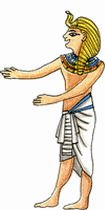
|
EGYPTIAN COINAGE
Ancient Egyptians practised barter for any goods for a long time. For daily transactions, the goods and wages were measured in terms of cereal bags, sometimes in beer jars, breads or clothes, or silver “seniou” and copper “deben” (two weight units) which, being nonperishable, could be saved, borrowed, etc.
In this context, a worn copper tool was still worth its weight of metal.
But if this could satisfy exchanges of everyday life, it was not enough for a centralized administration that required a precise accountancy of harvests, taxes, and so on.
We have to admit that the solutions they used were very effective, since it did not lead the Egyptians to imagine real currencie - even when they appeared in other countries, they did not hasten to adopt them.
Transactions in Pharaonic Egypt
The Egyptians undoubtedly used as of the Old Kingdom, a system defining the value of goods in parity with gold. During the 19th dynasty (New Kingdom), silver became the usual standard, probably because it was more in harmony with the trading practices in the Near East.
This required to manage a system of weight units to quantify the mass of metal which constitutes the standard. During the Old Kingdom, the Egyptians used a unit called " chat". It seems that the chat was dropped at the New Kingdom, in favour of a new unit, the deben.
And yet, even if a product’s worth was appraised like a given mass of silver, the Egyptians apparently felt reluctant to materialize this metal weight as a tangible mass.
Sometimes copper or silver rings are supposed to have been considered as exchange units, but even if the gold and silver gained from the mines were to be paid, the metal in itself had such a spiritual significance – gold was the flesh of gods, silver was their bones – that it perhaps prohibited its use for mercantile purposes. Some other explanations were considered, like the fear of frauds...
This system worked for centuries. We know the case of a painter of Deir-el-Medina who received as a wage " A woven clothing with a worth of 3 seniou, a bag with a worth of half a cereal bag, a mat and a blanket having a worth of a half seniou and a bronze vase for another half seniou".
First attempts
At the end of its history, Egypt underwent two periods of Persian domination - the first from 525 to 404 B.C and the second from 340 to 322 B.C., the year where Alexander the Great came.
On the one hand, the Persians knew and used currencies, and the governors (Satraps) were allowed to mint silver coins (gold was the prerogative of the Great King).
On the other hand, at the dawn of the second Persian occupation, the Greeks had lost most of their power. They had to conclude with Persia the peace of Antalcidas (386 B.C.), and the Egyptians of the 30rd dynasty were well aware of the threat of a new Persian invasion. Pharaohs Takhos and Nectanebo II had to call upon Greek mercenaries, who were accustomed to be paid in cash money.
In this circumstances appear coins imitating the Greek coinage, and rather basic gold coins known as “Nb nfr” inspired by the Persian currencies, but their use remained restricted.
.
Macedonian and Ptolemaic coinage
When Alexander the Great penetrated Egypt in 332 B.C., he brought with him the Macedonian coinage. The coins at his effigy became practically a universal currency. When he died, Ptolemy I inherited Egypt and made of the Egyptian coinage a royal monopoly, the only one that was allowed for circulation inside Egypt. He perpetuated the practice of silver and gold coinage introduced by Alexandre, and his successors generally went on (the king on one side of the coin, an image of Zeus and an eagle on the other). This period ended with the reign of Cleopatra in 30 B.C.
Romain coinage
The new master of Egypt, Augustus, carried on the closed monetary policy: the coins were minted by the prefect of Egypt, under the control of Rome. Then, in 294 A.D., emperor Diocletian lead a monetary reform, introducing a unique currency for all the roman empire, and opened in Alexandria a minting workshop (officina) like in other roman provinces. Like elsewhere, coins at the effigy of Trajan, of Hadrian, etc. circulate in Egypt.
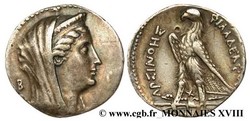
Tetradrachm, 246-245 B.C., silver,
diameter 26.5mm. |
Ptolemy II Philadelphus (285-246 B.C.)
Ptolemy II succeeded his father in 283 B.C. but he was already included in the monarchy before this date. Married in 288 B.C. to Arsinoe, Lysimachus’ daughter, he married then his sister Arsinoe II. Daughter of Ptolemy I and Berenice, she had married successively Lysimachus, then Ptolemy Ceraunos, her halfbrother, and was deified, identified with the goddess Hathor when she died in 271 B.C. Ptolemy ordered an important restitution coinage to celebrate her memory. During the twenty-five last years of his life, Ptolemy II had the lighthouse of Pharos finished.
Document CGB, www.cgb.fr |
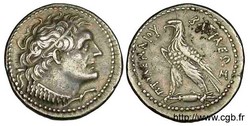
Tetradrachm, ca; 160 B.C., silver,
diameter 27.5mm.
|
Ptolemy VI Philometor (180-145 B.C.)
In the lagide coinage, the portrait of Ptolemy I Soter was re-used during nearly three centuries, fixed for eternity. Ptolemy’s portraits are realistic. This tetradrachm, without monogram nor symbol is difficult to ascribe. Thanks to the portrait’s style, we may credit this coin to Ptolemy VI. Ptolemy VI was the eldest son of Ptolemy V and Cleopatra I. The regency of his mother lasted until 176 B.C.He ruled together with his brother Ptolemy VIII from 170 to 164 B.C. He married his sister Cleopatra II with whom he had two daughters and Ptolemy VII. He died from the consequences of his wounds when he fought Alexander I Balas.
Document CGB, www.cgb.fr |
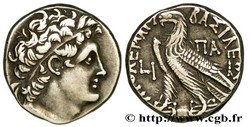
Tetradrachm, 116-107 B.C., silver,
diameter 24mm.
|
Ptolemy IX Soter II and Cleopatra III
Ptolemy IX, born in 141 B.C., was the oldest son of Ptolemy VIII Evergete (145-116 B.C.) and Cleopatra III. He succeeded his father in 116 B.C. He appointed his younger brother, Ptolemy X Alexander I, as governor of Cyprus in 113 B.C. In 106 B.C., he was enthroned by his brother and took his place in Cyprus. Ptolemy X reigned with his mother until her death. Finally, after a eighteen years reign, he was driven out by the Alexandrines and assassinated at sea in 88 B.C. Ptolemy IX Soter II then recovered his throne for the eight last years of his life.
Document CGB, www.cgb.fr |

Tétradrachm, 20 B.C., silver,
diameter 23.5mm.
|
Cleopatra VII and Ptolemy Cesarion (51-30 B.C.)
On this tetradrachm, Cleopatra VII is associated with her son, Ptolemy XV (44-31 B.C.), better known as Cesarion. On the last mints of Cleopatra, the portraits are very stylized and do not show the effigy of Egypt’s queen.
Document CGB, www.cgb.fr |
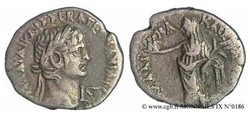
Tetradrachm, 45-46 A.D., billon,
diameter 23mm.
|
Claudius and Messalina, Britannicus and Octavia
Egypt, which constituted a closed world, was a province belonging to the emperor, controlled by a prefect (equestrian order). Alexandria’s coinage circulated only in Egypt. A billon tetradrachm of Alexandria was worth one roman silver denarius until the tetrarchic reform of 294. The drachma was worth six obols and there were billon tetradrachms, drachmas, hemidrachmas, diobols, obols and hemiobols made of bronze. The Egyptian year started in the month of August (29th). The reverse would represent Messalina, Claudius’ third wife and the mother of Britannicus and Octavia. Actually, this could be a representation of Demeter, goddess of the harvests. Wheat was the main resource of Egypt, which was one of the suplier of the annona.
Document CGB, www.cgb.fr |
|

















